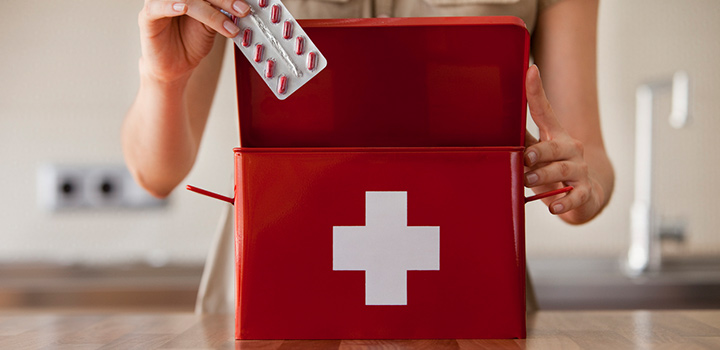Stock up this Spring: How to assemble your own first aid kit

A decent first aid kit is a household must-have. Many kits on offer promise to stock everything you might need, but it’s a sure bet if you assemble your own. Here are some first aid essentials.
A first aid kit consists of medical supplies used to help stabilise a person who is sick or injured until they can be treated by a trained healthcare provider like a nurse, paramedic or doctor. You can also use these emergency supplies to treat minor illness or injuries that don’t require advanced medical care, like indigestion, headaches, minor scrapes and insect bites.
Whether you’re buying one and enhancing it, or building your own from scratch, here’s a list of basic supplies your kit should contain.
Check the instructions before you use medicines
If you decide to include medicine in your kit, make sure you also include the instructions which show dosage, interaction and contraindication information. Even your kit is just for home use, you might have to treat a friend or visitor who takes chronic medication or who has an allergy. Be especially careful when administering medicine to children.
Medicines in individual packets are ideal for first aid kits as they’re more compact, encourage correct dosing, and protect unused portions of the medicine from oxidation. You can also consider using generic medicine as it works just as well, but is more cost-effective.
Medicines to consider including in your kit
- Sore throat soothers
- Antacids for indigestion
- Painkillers and fever-reducing medicine like paracetamol, ibuprofen and aspirin. Remember that aspirin can make bleeding worse, so don’t give it to someone with a bleeding disorder or open wounds.
- Oral rehydration sachets containing electrolytes
- Medicine for the relief of nausea and vomiting
- Medicine for an upset stomach to stop diarrhoea and cramps
- A laxative for constipation
- Antihistamine tablets to relieve allergies and a topical cream for insect bites and stings
- Decongestant for a stuffy nose
- Saline eye drops for dry or itchy eyes
Equipment to consider including in your kit
- A thermometer
- Plasters of different sizes
- Antiseptic ointment to prevent infection in minor cuts and abrasions
- Gauze
- Disinfectant
- Bandages
- A topical nonsteroidal anti-inflammatory gel, cream or spray
- Products for burn care
- Scissors
- Tweezers
- Wound-closing strips
We also put together a list of important factors to consider for a first aid kit read the article here Keep these factors in mind as you decide exactly what goes into your first aid kit. Then use our lists above as a reference point to make sure you’re well-equipped and ready for a household accident.
Learn how to handle an emergency - sign up for a CPR course today
Cardiopulmonary resuscitation (CPR) is an emergency technique used on someone whose heart or breathing has stopped. Knowing how to perform CPR can literally save lives, so don’t wait until you wish you did – sign up for a course today!
With Discovery Vitality, you’ll earn 2 500 Vitality points for successfully completing a CPR course. Find a list of providers and learn more about this vital skillset here.
Related articles
Having bipolar disorder doesn't define me
Discovery Health Medical Scheme member, Emma Attwell opens up about her journey with mental illness and shares the value of sound medical aid when faced with numerous health challenges.
The emotional impact of a cancer diagnosis
A cancer diagnosis can be traumatic, both as a patient and as a loved one. Here’s what to expect.
Learning from adversity: A Breast Cancer survivor's story
Norma Moller shares her experiences during her rollercoaster cancer treatment journey that has left her wiser, Learning more aware, more disciplined, and an expert when it comes to her own body.